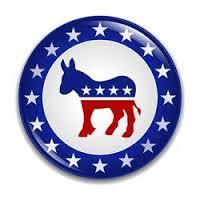 I’ll cut to the recommendation first: If you’re a donor, and wish to support state and local parties, then cut the check to them directly. Don’t send funds to the DNC or to Joint Fundraising Committees. If Democrats want to have a 50 state strategy, we should give directly to state parties.
I’ll cut to the recommendation first: If you’re a donor, and wish to support state and local parties, then cut the check to them directly. Don’t send funds to the DNC or to Joint Fundraising Committees. If Democrats want to have a 50 state strategy, we should give directly to state parties.I’ll go into this in detail below the fold, but here’s the gist. I looked at the flows of contributions during the 2016 campaign between the biggest Joint Fundraising Committee (which raised over $530 million), the DNC and state parties. Donations made to the Joint Fundraising Committee end up primarily with presidential campaigns, back at the DNC, or redirected to states that are a priority for the presidential race.
Only a very small amount will actually make it down to non-battleground states to express a 50 state strategy. Fundraisers working for presidential campaigns feel they’ve brought in the money and should be able to direct it where they believe it will best help them. The DNC assisted in the effort.
If we believe that state parties should be strengthened, if we trust they know best how to organize and run campaigns in their states, if we want a 50 state strategy, then we should give directly to the state parties. Take what presidential campaign fund-raisers tell you about helping state parties with a grain of salt. Their priority is always going to be the top of the ticket, the presidential campaign.
If you’re in a state that you think don’t needs help, adopt a different state and give to them (both time and money). My “adopted state” is Montana.
Why am I bothering with this?
Here’s what got me going on this. Back in May and July of last year, Politico published a couple of articles about how little money state parties were getting from Joint Fundraising Committees they’d signed up for.
I did a diary at the time: Dear state party: We’re wiring $1 million, wire 900k of it to the DNC today (wink wink nudge nudge). The story was about the Hillary Victory Fund, a Joint Fundraising Committee (JFC) set up between the presidential campaign, the DNC and state parties. The joint effort allowed the committee to ask a donor for over $700,000 in total. This was accomplished by pooling together all their contribution limits for state, national parties and the presidential campaign. Several donors did in fact make such large donations, and at least some thought (or said) it would be going to state parties or “down-ticket”:
Then he [George Clooney] told Todd, “The overwhelming amount of money that we’re raising, and it is a lot, but the overwhelming amount of the money that we’re raising is not going to Hillary to run for president, it’s going to the down-ticket. — www.politico.com/…
I decided to take another look at this after questions were raised during the KS-4 special election. James Thompson’s campaign wanted the state party to kick in $20k, but they had a lot of other competing priorities. There was some discussion about DNC/JFC contributions and how small they ended up being. They were also meant for the 2016 campaign, but anyway, this is what prompted me to take another look.
So, what did I find?
I used data from the reports on transfer to/from affiliated committees at the FEC for the following committees/parties:
- Hillary Victory Fund: C00586537
- DNC Services Corp./DEM. NAT’L COMMITTEE: C00010603
These reports have information on what state parties received from the DNC and JFC, and what they sent to the DNC. The DNC and state parties can legally transfer unlimited funds amongst themselves. The JFC disbursed funds to the state parties based on a pre-agreed allocation formula. Donors who hit their contribution limits for the presidential campaign or DNC would see surplus funds sent to state parties.

The Joint Fundraising Committee (JFC) raised $530 million during the cycle. 27.4% of that went to pay for expenses, much of which was advertising that was similar to the presidential campaign and helped drive small contributions (not subject to limits).
$378 million (71.4%) was distributed the committees. Of that, 41% ($158 million) went to the presidential campaign committee which had also raised another $408 million on its own. A further 28% ($107 million) went to the DNC. That left 31% ($122 million) for the state parties.
$122 million sounds pretty good. What’s even better is that $94 million went to the 44 non-battleground states. And then something else happened. The DNC recalled $85 million from the states. That left $37 million with the states. Whoa, doesn’t sound as good.

Then, the DNC distributed funds to state parties again, and they distributed more than the $85 million they’d taken out. They sent $114 million down to the states. That sounds really good!
But here’s the catch. The redistribution favored the 6 presidential battleground states disproportionately (FL, PA, OH, NC, NV and VA). These 6 battleground states net over $96 million from the DNC and JFC combined. That’s over $16 million per state. The remaining 44 state parties (plus territories) received only $55 million. That’s $1.1 million per state. A fifteen to one disparity. If we think about it another way, the six battleground states between them had 80 House seats at stake. That’s $1.2 million per house seat. The remaining 355 voting house seats got $155,000 each.
| CATEGORY | RECEIVED FROM JFC | LESS TRANSFERRED TO DNC | PLUS TRANSFERS FROM DNC |
|---|---|---|---|
| PRESIDENTIAL CAMPAIGN | $158,200,000 | $158,200,000 | $158,200,000 |
| DNC | $107,533,318 | $192,709,118 | $68,460,077 |
| BATTLEGROUND STATE PARTY | $18,580,413 | $12,001,913 | $95,566,561 |
| STATE PARTY | $93,780,949 | $15,183,649 | $55,868,042 |
| TOTAL | $378,094,680 | $378,094,680 | $378,094,680 |
PS. Michigan, Minnesota and Wisconsin should have been in that mix of battleground, but that’s hindsight. Also, not every state participated in the joint fundraising with JFC, only 38 of them did. The DNC also transferred funds to states that weren’t in the JFC. Bernie’s JFC sent 250k to the DNC, I did not include that in this calculation.
What does this tell us? Basically, that the DNC and the Joint Fundraising Committee were focused on the presidential campaign. Heck, that is actually the DNC’s job and the Joint Fund-raising committee was called “Hillary Victory Fund”. It wasn’t called “50 state strategy, down-ballot candidates Victory Fund”. So it should be obvious what the intention is.
However, claims were made that donations would help build state parties and down-ballot candidates. At least when we follow the money, that doesn’t seem to be true.
As an aside, the same thing was happening on the Republican end as well. Kansas Republicans got $1.35 million from their JFC (Trump Victory), and they sent $1.37 million back up to the RNC.
Which states got the least?
I’ll share the complete data set I was working with in a comment after a couple of days. But here are a bunch of states that were part of the Joint Fundraising Committee and received money from the Joint Fundraising Committee, only to send it up to the DNC almost immediately. They were essentially used as a pass through account.
| STATE | FROM JFC | SENT TO DNC | LEFT WITH | DNC LATER SENT | NET | NET AS % OF JFC |
|---|---|---|---|---|---|---|
| MISSOURI | $3,043,700 | $3,033,700 | $10,000 | $693,142 | $703,142 | 23% |
| INDIANA | $3,015,400 | $2,947,000 | $68,400 | $634,688 | $703,088 | 23% |
| NEW MEXICO | $2,494,300 | $2,494,300 | $- | $649,690 | $649,690 | 26% |
| TEXAS | $2,993,000 | $2,978,000 | $15,000 | $523,625 | $538,625 | 18% |
| LOUISIANA | $3,018,100 | $3,008,100 | $10,000 | $424,981 | $434,981 | 14% |
| OREGON | $3,024,500 | $3,014,500 | $10,000 | $339,004 | $349,004 | 12% |
| UTAH | $3,011,700 | $3,001,700 | $10,000 | $328,576 | $338,576 | 11% |
| MISSISSIPPI | $3,025,700 | $3,015,700 | $10,000 | $313,120 | $323,120 | 11% |
| KANSAS | $2,496,300 | $2,496,300 | $- | $317,766 | $317,766 | 13% |
| ALASKA | $3,005,700 | $2,995,700 | $10,000 | $298,125 | $308,125 | 10% |
| OKLAHOMA | $3,013,100 | $3,003,100 | $10,000 | $296,830 | $306,830 | 10% |
| NEW JERSEY | $2,509,800 | $2,509,800 | $- | $300,009 | $300,009 | 12% |
| MONTANA | $2,996,900 | $2,986,900 | $10,000 | $289,273 | $299,273 | 10% |
| WYOMING | $3,023,500 | $2,970,000 | $53,500 | $225,933 | $279,433 | 9% |
| MASSACHUSETTS | $3,017,800 | $3,005,800 | $12,000 | $260,809 | $272,809 | 9% |
| WEST VIRGINIA | $3,015,400 | $3,005,400 | $10,000 | $262,012 | $272,012 | 9% |
Many of them have small populations, are deep red/blue and didn’t have a senate race. But they did participated in the JFC and their contribution limits helped raise high-dollar amounts from donors. And these state parties need the money. Let’s take Kansas for example, they raised about $800k from other sources for this cycle. Their total operating budget was $1.2 million, which was better than Kansas Republicans at $423k, but if they’d been able to keep a larger portion of the $3 million they initially received, the party would be transformed.
Mississippi, is an even more extreme example. Mississippi Democrats raised $140k total, their total operating expenses were $454k. That’s for the entire 2016 cycle, start to finish. If Mississippi had been able to keep the $3 million initially sent to them by the JFC, the state party would have had ten times the money they did. They might have been able to run more voter registration drives, help with local campaigns, groom future candidates, support volunteers on the ground. Instead, they sent it back to the DNC, who in turn sent it to Ohio because it was a priority for the presidential campaign.
Yes, this ignores many things. The presidential campaign and DNC spent on technology that arguably helped all. The DNC funded the convention, education and training for state parties. A presidential campaign has coat-tails and presidential campaigns help turn out the vote for down-ballot candidates. But did that really happen in Mississippi?
PS. Let’s avoid the pie fight in this diary, that was not the intent here. When I write a pie-fight diary you’ll know it.
— Cross-posted at DailyKos | @subirgrewal
 James Thompson lost last night. I want to discuss why national Democrats (DCCC, DNC, Senators, etc) were conspicuously absent from the KS-4 race. I think these are worth discussing, since the same questions will come up in the other races. Particularly MT-AL, where Rob Quist is running.
James Thompson lost last night. I want to discuss why national Democrats (DCCC, DNC, Senators, etc) were conspicuously absent from the KS-4 race. I think these are worth discussing, since the same questions will come up in the other races. Particularly MT-AL, where Rob Quist is running.